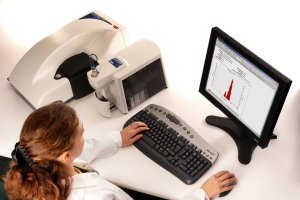Researchers at the University of Potsdam, Germany, are using a Zetasizer Nano ZS from Malvern Panalytical to measure the dimensions and stability of gold nanoparticles smaller than 5 nm in diameter.

Gold has long been considered as an inert element, but in nanoparticulate form it can be very reactive. For particles under 5 nm the surface electrons increasingly dominate the properties of the surface and consequently of the system. This makes gold nanoparticles interesting for life science applications, in tagging viruses and cells for example.
Sabine Kosmella and Joachim Koetz made the ultrafine nanoparticles in a one-step reaction using gold chloride and an oligosaccharide-modified hyper-branched polyethylenimine (PEI). The PEI is a polyelectrolyte that acts as a reducing agent as well as a stabilising agent. To make the particles, a mixture of gold chloride and PEI in solution is heated to 100 degC. This results in a dispersion of gold nanoparticles, which turn the solution red.
With the Zetasizer Nano the researchers were able to show that the average diameter of the particles was less than 5 nm and to determine the zeta potential of the dispersion, an indicator of its stability.
"Being able to measure particle size is important for the determination of the hydrodynamic radius of the particles including the polymer shell in comparison to other methods like TEM, visualising the particle radius without polymer shell" said Dr Kosmella.
The Zetasizer Nano ZS from Malvern Panalytical enables the measurement of both particle size, from 0.6nm to 6000 nm, and zeta potential in a single instrument. The technology built into the system provides the sensitivity required for measuring dilute proteins and polymers, as well as the ability to measure emulsions and suspensions at high concentrations. It is the method of choice for nano-particle applications from routine colloid size measurements to the investigation of particulates at the leading edge of materials research. www.malvern.com/zetasizernano
Malvern Panalytical, Malvern Panalytical and Zetasizer are registered trademarks of Malvern Panalytical